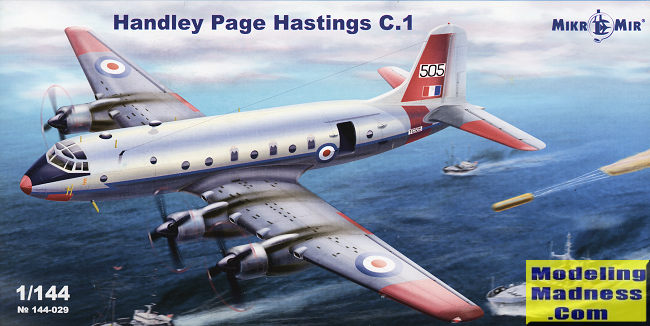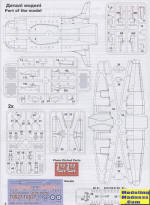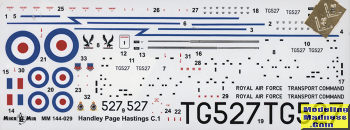
Mikro-Mir 1/144 Handley-Page Hastings
| KIT #: | 144-029 |
| PRICE: | @$42.00 delivered |
| DECALS: | Two options |
| REVIEWER: | Scott Van Aken |
| NOTES: | New tool (2021) |

| HISTORY |
The Handley Page HP.67 Hastings was a British troop-carrier and freight transport aircraft designed and manufactured by aviation company Handley Page for the Royal Air Force (RAF). Upon its introduction to service during September 1948, the Hastings was the largest transport plane ever designed for the service.
Development of the Hastings had been initiated during the Second World War in response to Air Staff Specification C.3/44, which sought a new large four-engined transport aircraft for the RAF. Early on, development of a civil-oriented derivative had been prioritised by the company, but this direction was reversed following an accident. On 7 May 1946, the first prototype conducted its maiden flight; testing revealed some unfavourable flight characteristics, which were successfully addressed via tail modifications. The type was rushed into service so that it could participate in the Berlin Airlift; reportedly, the fleet of 32 Hastings to be deployed during the RAF operation delivered a combined total of 55,000 tons (49,900 tonnes) of supplies to the city.
As the RAF's Hastings fleet expanded during the late 1940s and early 1950s, it supplemented and eventually replaced the wartime Avro York, a transport derivative of the famed Avro Lancaster bomber. RAF Transport Command operated the Hastings as the RAF's standard long-range transport; as a logistics platform, it contributed heavily during conflicts such as the Suez Crisis and the Indonesian Confrontation. A handful were also procured by the Royal New Zealand Air Force (RNZAF) to meet its transport needs. Beyond its use as a transport, several Hastings were modified to perform weather forecasting, training, and VIP duties. A civilian version of the Hastings, the Handley Page Hermes, was also produced, which only achieved limited sales. Hastings continued to be heavily used by RAF up until the late 1960s, the fleet being withdrawn in its entirety during 1977. The type was succeeded by various turboprop-powered designs, including the Bristol Britannia and the American-built Lockheed Hercules.
| THE KIT |
 This
is a fairly standard short run kit with a lot of smallish sprues that show
the size limitations of their molding equipment. There are a lot of sprue
attachment points on the parts and on the large parts, they intrude onto the
mating surfaces. Though not all 1/144 kits have interiors, this one does
with a cockpit that consists of a pair of control columns, a pair of seats,
and a center console. There is a rear bulkhead as well.
This
is a fairly standard short run kit with a lot of smallish sprues that show
the size limitations of their molding equipment. There are a lot of sprue
attachment points on the parts and on the large parts, they intrude onto the
mating surfaces. Though not all 1/144 kits have interiors, this one does
with a cockpit that consists of a pair of control columns, a pair of seats,
and a center console. There is a rear bulkhead as well.
The kit has a lot of small
cabin windows to install, though some may well wish to use a liquid mask or
something similar to draw across the openings when the kit is nearly done.
Interestingly, one fuselage half includes half the rudder while the other piece
is separate. Before closing the fuselage, the instrument panel and cockpit as
well as the tailplane insert need to be installed. As this s a tail dragger, no
weight is needed.
 he
main gear assembly. Last items are a pair of underwing fuel tanks, though most
period photos show them without the tanks.
he
main gear assembly. Last items are a pair of underwing fuel tanks, though most
period photos show them without the tanks.
| CONCLUSIONS |
| REFERENCES |
https://en.wikipedia.org/wiki/Handley_Page_Hastings
June 2021
Copyright ModelingMadness.com. All rights reserved. No reproduction in part or in whole without express permission.
Back to the Previews Index Page
Back to the Previews Index Page